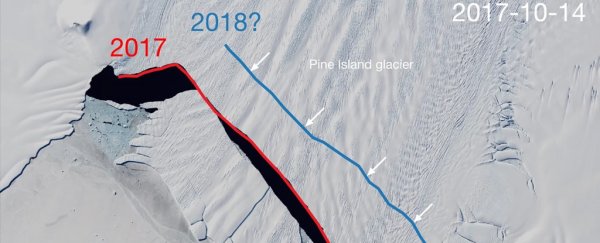Antarctica's Pine Island glacier could soon lose another massive chunk of ice, with signs of a 30 kilometre (19 mile) long crack appearing along its surface.
Only a year ago a 260 square kilometre (100 square mile) iceberg split free from the glacier – the fifth large calving event this century. That makes this one a potential number six, reflecting an alarming trend that could eventually have an impact on rising sea levels.
Remote sensing scientist Stef Lhermitte from Delft University of Technology in the Netherlands noticed the rift last week, when he received a daily image update covering the site. He shared his findings on Twitter.
Satellite pictures of the glacier's ice shelf clearly show a dark line appearing across its middle.
The upcoming ~300km iceberg (or its disintegrated pieces) will be the next large calving event after iceberg B-44 last year and the 6th large calving of #PIG since 2018 [2/n] pic.twitter.com/LdJ2caJrhv
— Stef Lhermitte (@StefLhermitte) October 4, 2018
There are still roughly 10 kilometres of ice connecting the prospective iceberg to the end of the glacier; once that breaks free in the coming weeks or months, it will be a monstrous 300 square kilometre (115 square mile) island adrift in the Antarctic's oceans.
Icebergs aren't exactly rare objects in the South Pole's surrounding oceans, of course, and a rift in the floating raft of ice at the end of an enormous glacier isn't an alarming discovery on its own.
What is of concern is the nature and the timing of the break. Most calving events usually occur along the sides of the glacier. This one runs deep inside, straight along the middle, hinting at a hot water bath beneath.
These types of iceberg calvings are also starting to happen more often than we'd expect, in line with a rise in the rate of melting ice in West Antarctica.
Global warming is clearly not helping matters, but recent research suggests a subterranean source of energy might also be at work in the area, with news of volcanic heat potentially pushing up temperatures beneath the ice shelf.
This double whammy seems to be speeding up the disintegration of Pine Island glacier's fat ice tongue.
Without that massive doorstop slowing the solid river at its back, we might expect the conveyor belt of ice to slide into the ocean at an ever-increasing rate.
If the entire Pine Island glacier were to be added to the world's oceans, we'd see a sea level rise of around half a metre (about 1.7 feet).
This is a worst-case scenario, but given the way things are going, worst cases are actually starting to look more and more plausible. For now, scientists will be closely watching that ice rift.
